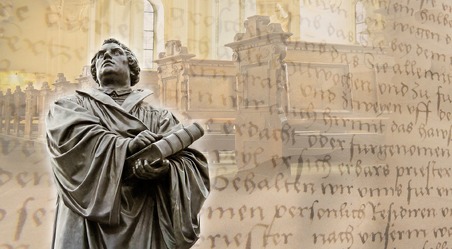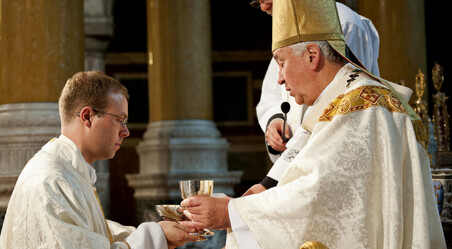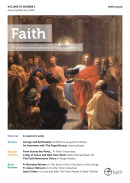Featured
A fresh look at Martin Luther

Richard Rex looks at Martin Luther’s work, half a millennia after the famous declaration at Worms
Science and the Catholic Faith

Dermott O’Gorman offers a meditation on the Epiphany
Why is evangelisation so important?

Fr Michael Nazir-Ali examines a central topic for today
Holloway on... The theme of the priesthood

Father Edward Holloway explores the Sacrament of Order
Book Review: The Faith Movement and Vocations

The Impact of the Faith Movement on Priestly Vocations: Within the context of New Ecclesial Movements by Dr Julie Mersey, [independently published], 351pp, £9.99.
Book Review: How to combat threats to human life

How to combat threats to human life
A Good Life-At Any Price — New Threats to Human Life in Our Times by Anita Dowsing, Gracewing, £14.98.
Review by Pravin Thevathasan
Book Review: A stirring call to spiritual arms

A stirring call to spiritual arms
Christian Asceticism by Anselm Stolz OSB, tr. Giles Conacher OSB, Arouca Press, xxxii+159pp, £18.99 (hardback), £13.99 (paperback)
Review by Sr. Mary Thomas
Book Review: Grace through Mary's hands

Grace through Mary’s hands
A Retreat on The Immaculate Conception of the Blessed Virgin Mary, Cadoc D. Leighton, OPraem., Gracewing, 42pp, £3.50, $4.95 USA
Review by Sr Mary Dominic Pitts
-
The Signs of the Times
When the idea of a youth group as part of the Faith Movement was first being discussed, one possible name suggested was “The 72” (Luke:10).
This was the 1970s and someone commented that it sounded like the name of a pop group. Others felt that giving such a specific number would, to the Scripturally illiterate, seem to be a rather random restriction on recruitment…
The Faith Movement has since grown and flourished: in 2022 as we mark the 50th anniversary of 1972, the regular “Faithvine” of news each month is filled with snippets about weddings, baptisms, priests’ appointments, and the like, as new generations follow in the footsteps of “the 72”.
Please God, we can hope that 2022 will see — as 2020 and 21 could not — some Faith Movement events. After these bleak times of lockdown and semi-lockdown, memories stir. Summer Sessions with afternoons in sunshine… inspiring talks and long thoughtful conversations, swimming and football sessions, beautiful Masses, processions with candlelight and glorious singing….and quiz-nights and concerts and more…and, usually, a great firework display on the final evening, putting a seal on another unforgettable gathering.
The Summer Session has been written into the memories of men and women now in middle age, or old age, who look back at fading pictures with laughter at 1970s haircuts or with memories of the first ceilidhs which established a tradition and transformed evenings which had formerly included rather underwhelming discos…
As we look to the future, there are of course new chapters to be written and new hopes. The key is the teaching and explanation of the synthesis of faith and science, God’s “master key” and the centrality of Jesus Christ as Saviour and Lord.
The Church must always be alive to the “signs of the times”. It is easy for Catholics to misunderstand these. The phrase does not mean that we should become absorbed into the immediate worries and concerns of each decade. The Church was right, at the Second Vatican Council, to be aware of the larger things that were emerging, beyond the immediate concerns of the post-WWII Cold War, the horrors of Communism, and the threat of atomic war. Today, in ways that could not be seen in the 1960s and 70s, but was somehow understood at a deeper level as being possible, the Church thrives with astonishing growth across Africa, faces renewed persecution under Islam, and sees new challenges in the era of immediate communication, the internet, and more. The Council equipped the Church for these things, somehow grasping the signs of “the times” as being more than signs immediately apparent in the 1960s.
In the 19th century, Cardinal Manning, Archbishop of Westminster, believed passionately that the future security of the Church depended on the continuation of power in Papal States and the Pope as the temporal ruler of that part of Italy. St John Henry Newman did not share this belief, though obeyed his own bishop, Ullathorne, when told he must preach a sermon on the subject. The result was a carefully nuanced and wise approach which proved to be prophetic. The Lateran Treaty of the early 20th century resolved a problem which had seemed intractable in the 19th century.
At the end of the 20th century there was a sense of fear among many that the year 2000 would bring some sort of dramatic horror. A widespread notion was that of civic breakdown due to “Y2K”, the collapse of all computer networks at the calendar change. On-line discussions on this, together with a rash of paperback books and lots of general gossip, often focused on the notion that all of this presaged the End Times, with Christ’s return following an era of horror. It didn’t happen. The world’s computers worked normally. The real “signs of the times” are not always the things that capture the public or even the Catholic imagination.
Meanwhile in both the 19th and the 20th centuries, and on into the 21st, the issue of “science and religion” throbbed and jingled in hearts and minds, in academia and in politics, in families and religious communities, both in the developed world and in the emerging former missionary lands with new generations asking the challenging questions. The issue was one which fomented Marxism, nourished the attacks on the Church under the Nazis, and fostered confusion and disillusionment within formerly confident Christian communities. Above all, it is a dominant issue among young people. To respond to it is to respond at a deep level to the “signs of the times”. The Faith Movement tackles this as its core mission.
Newman understood that questions concerning, for example, evolution and Genesis, were important, and that failure to explain and teach an authentic message would result in cynicism and disbelief. The signs of the times demanded a response to the questions being raised by a rising belief that “science” had disproved ideas once thought to be secure. The Faith Movement has this same understanding, and offers a coherent vision that moves forward to evangelisation of a world that needs Christ, Redeemer and Lord.



















